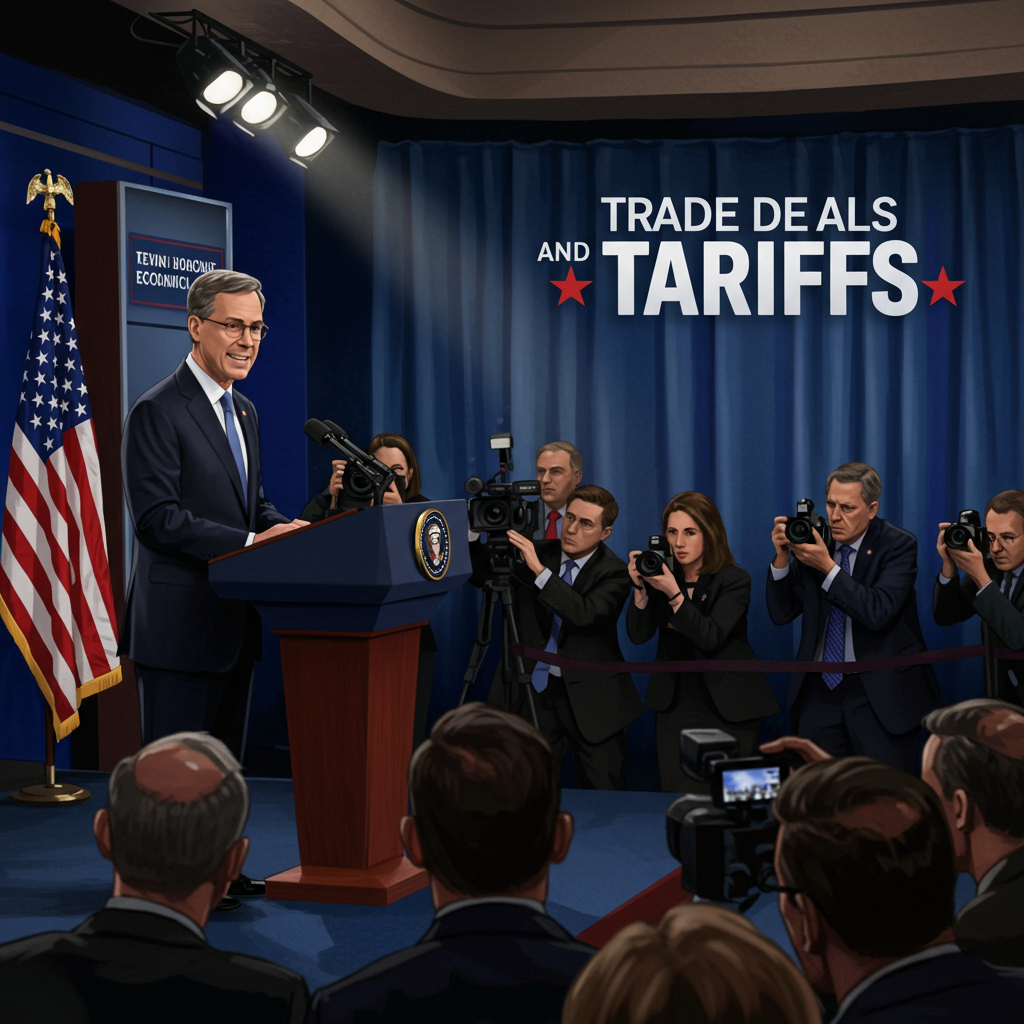White House National economic Council Director Kevin hassett recently offered insights into the status of U.S. trade negotiations as a critical tariff deadline approaches. Speaking on “Face the Nation,” Hassett indicated that the “rough outlines of the deals are becoming clear,” signaling potential breakthroughs ahead of a key date that could see significant tariff changes implemented. His comments come as the administration pushes to finalize agreements with various trading partners under pressure from potential U.S. levies.
The impending deadline follows President Trump’s earlier decision to pause the imposition of sweeping new U.S. tariffs. Initially, a 10% baseline tariff was unveiled for most partners back in April. However, after market volatility, the administration announced a 90-day reprieve on most new tariffs. Notably, this pause did not prevent a substantial increase in the tariff rate on goods imported from China, which was raised to an across-the-board 30%. That 90-day pause was set to expire around the middle of the week following Hassett’s interview.
Progress and Pressure in Trade Negotiations
Hassett highlighted that agreements recently concluded, specifically mentioning those with the United Kingdom and Vietnam, are serving as potential templates. He suggested these deals provide valuable “guidelines for what might happen” as the U.S. seeks similar arrangements with other nations. The overall objective remains reciprocal trade conditions where partners open their markets to U.S. products while allowing the U.S. to impose its tariffs.
The White House anticipates a busy week with expectations that several trade deals could be finalized. However, for countries where negotiations have not advanced sufficiently by the deadline, the administration plans to send formal letters. President Trump himself confirmed this approach, stating that correspondence would begin going out to roughly a dozen countries shortly after Hassett’s appearance. While Hassett didn’t specify which countries would receive these letters, he noted they could include both major and minor trading partners. He suggested that successful agreements could transform smaller partners into significantly larger ones over time.
What Happens if Deals Aren’t Reached?
Treasury Secretary Scott Bessent provided further clarity on the implications of these letters and the upcoming dates. He explained that the letters would effectively inform nations that failure to make adequate progress would result in a “boomerang back to your April 2 tariff level” on August 1. Bessent emphasized that August 1 should not be viewed as a new negotiation deadline. Instead, it represents the date when the previously established April 2 tariff rates will take effect for countries without finalized deals, unless alternative arrangements are agreed upon.
When pressed on whether the tariff pause might be extended for important trading partners if agreements aren’t ready, Hassett offered a somewhat non-committal response. He stated that the U.S. is “always willing to talk.” While acknowledging the presence of deadlines, he conceded that “maybe things will push back past the deadline, or maybe they won’t.” Ultimately, Hassett indicated that President Trump would make the final determination on such matters. This suggests a degree of flexibility, though the administration is clearly applying pressure.
Economic Strategy and Policy Debates
Beyond the immediate tariff deadlines, Hassett also championed the administration’s broader economic strategy. He argued that the potential threat of high U.S. tariffs, leveraged by President Trump, is having a powerful effect on global companies. Hassett contended that this pressure is accelerating the trend of foreign entities moving their economic activities and production lines into the United States. This phenomenon, often referred to as “on-shoring” or “reshoring,” is, in his view, a direct result of the administration’s trade posture.
Hassett linked this perceived on-shoring “race” to positive economic indicators. He cited “record job creation” and “record capital spending” since the administration took office. He claimed that over 2 million jobs had been created during this period. Furthermore, he asserted that wage growth was rising and approaching levels seen in 2017. According to Hassett, this demonstrated how the administration’s policies, including the use of tariffs as a negotiating tool, were effectively stimulating the domestic economy and creating jobs for American workers.
The “Big Beautiful Bill” Controversy
A significant portion of Hassett’s interview focused on defending the administration’s recently signed “One Big Beautiful Bill,” a comprehensive tax cut and spending plan. This bill had faced considerable criticism, particularly regarding its projected impact on the national deficit. Estimates from various independent organizations, such as the Yale Budget Lab, the Tax Foundation, and the Committee for a Responsible Federal Budget, projected deficit increases ranging from $3 trillion to $5 trillion over a decade. Even Speaker Johnson reportedly agreed with a projection over $4 trillion.
Hassett vigorously disputed these figures. He maintained that the administration’s internal projections, based on its own economic modeling, showed the bill would actually shrink the deficit by $1.5 trillion over ten years. He attributed this stark difference to fundamentally different macroeconomic models used by forecasters like the Congressional Budget Office (CBO). Hassett argued that the administration’s models, which correctly predicted 3% GDP growth in the past, indicated the new bill would stimulate even greater growth. This accelerated growth, he claimed, would generate an additional $4 trillion in tax revenue compared to projections based on slower growth forecasts from groups like the CBO (which he suggested forecast around 1.8% growth).
Hassett was notably critical of the CBO, accusing the organization and others like it of having consistently poor track records in economic forecasting. He suggested they lacked robust macroeconomic models and failed to analyze the reasons behind their past inaccuracies, recommending they study the work of economist Jim Stock. Hassett went further, arguing that not passing the bill would have been economically disastrous. He projected that inaction would lead to a major tax hike, a 4% drop in GDP, and the loss of 9 million jobs, ultimately worsening the deficit far more than enacting the bill.
Centrist Democrat Congressman Tom Suozzi offered a contrasting perspective on the bill, calling it the “big, ugly bill.” He echoed concerns about the massive increase in the deficit, warning of inflation and high interest rates that could make things like buying a home difficult. Suozzi also strongly criticized the bill’s healthcare provisions.
Debating Medicaid Coverage and Healthcare Reforms
Another key area of contention addressed by Hassett was the bill’s projected impact on healthcare coverage, particularly Medicaid. The CBO had estimated that the new law could lead to up to 12 million Americans losing Medicaid coverage. Hassett challenged this projection on multiple grounds, suggesting it did not “make sense.”
Firstly, he described the bill’s work requirement for Medicaid recipients as minimal, stating it primarily involved looking for work or volunteering and included exemptions, such as for parents with young children (under 14). He argued this provision alone wouldn’t result in such significant coverage losses. Secondly, Hassett claimed that approximately 5 million individuals included in the CBO’s loss projection already held other forms of health insurance and thus would remain covered through alternative means.
Hassett further attacked the CBO’s forecasting by referencing past predictions. He cited the CBO’s 2017 projections regarding work requirements under the Affordable Care Act (ACA), where he claimed they predicted losses. Conversely, Hassett argued that the number of insured Americans increased by over 10 million in the two years following those projections. He attributed this rise to job creation leading people to gain employer-sponsored insurance, linking this past trend to his belief that the new bill’s job creation effects would similarly lead to more people acquiring health coverage, offsetting any Medicaid losses.
He reiterated his assertion that the CBO has a very poor record in healthcare forecasting, specifically mentioning errors in predicting the mix of private insurance versus Medicaid uptake under the ACA. He also claimed the CBO historically underestimates actual Medicaid spending by as much as 20%. Hassett reframed concerns about the elimination of enhanced ACA subsidies. He characterized this not as removing affordable coverage but as correcting a practice where states allegedly used a “trick” involving taxing hospitals after receiving federal matching funds, leading to what he described as 20% federal overspending on Medicaid. While this measure involves a “haircut” to that practice, he noted the bill allocates $50 billion to a trust fund intended to support rural hospitals.
In contrast, Congressman Suozzi viewed the healthcare changes as a “backdoor way to undo the Affordable Care Act.” He argued the bill takes healthcare away from needy individuals and would increase health insurance costs. Suozzi disputed the necessity of work requirements for Medicaid, stating that the vast majority (92%) already work, and most of the remaining 8% are caring for disabled children. He emphasized that Medicaid serves as a “lifeline” for vulnerable populations, including nursing home residents and veterans.
Overall, Hassett expressed confidence in the administration’s economic outlook and policy trajectory, attributing discrepancies with other forecasters to what he considers outdated and inaccurate modeling. He sees the pressure from potential tariffs as a successful tool driving domestic investment and job growth. However, the debate over the specifics of the new trade deals, the economic impact of the major spending bill, and its effects on healthcare coverage remain subjects of intense disagreement among policymakers and forecasters.
Frequently Asked Questions
What did Kevin Hassett say about the upcoming tariff deadline?
White House National Economic Council Director Kevin Hassett stated that “rough outlines of the deals are becoming clear” as a key tariff deadline approaches. He anticipated significant news this week, with some trade deals expected to be finalized. For countries without sufficient progress, letters outlining the U.S. position are being sent.
What happens to countries that don’t finalize trade deals by the tariff deadline?
For countries that haven’t made sufficient progress on trade deals by the deadline, letters will be sent. Treasury Secretary Scott Bessent clarified that failure to advance would result in their tariffs “boomeranging back to your April 2 tariff level” effective August 1. This August 1 date marks when tariff changes take effect if deals aren’t completed, not a new negotiation deadline.
How did Kevin Hassett defend the economic impacts of the “Big Beautiful Bill”?
Kevin Hassett strongly defended the bill, claiming it would shrink the deficit by $1.5 trillion over a decade, contrary to external projections of trillions in increases. He based his claim on administration models predicting strong GDP growth (3%), which he argued would generate significantly more tax revenue than models used by groups like the CBO, which he criticized as outdated and inaccurate. He also linked the bill to job creation and wage growth.
Conclusion
As the U.S. faces a crucial tariff deadline, Kevin Hassett’s comments underscore the administration’s active pursuit of new trade agreements. The White House is leveraging the potential threat of increased tariffs to push partners toward deals, seeing successful agreements as models for future negotiations. While the administration expresses confidence in its economic strategy, including the impacts of the recent “Big Beautiful Bill,” significant disagreements persist with independent forecasters and political opponents regarding deficit projections and healthcare coverage changes, particularly concerning Medicaid. The coming days are expected to reveal the outcomes of these intensified trade talks and set the stage for the next phase of the administration’s tariff policy.




